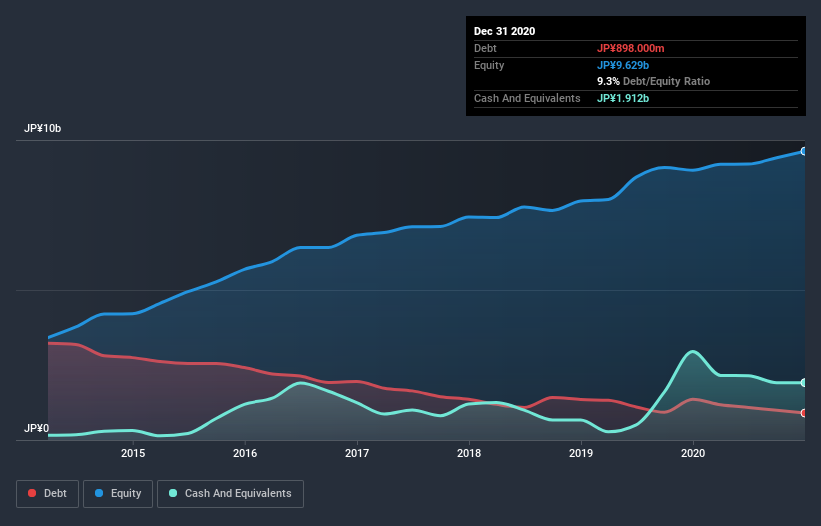
Legendary fund manager Li Lu (who Charlie Munger backed) once said, 'The biggest investment risk is not the volatility of prices, but whether you will suffer a permanent loss of capital.' So it seems the smart money knows that debt - which is usually involved in bankruptcies - is a very important factor, when you assess how risky a company is. As with many other companies Takahashi Curtain Wall Corporation (TYO:1994) makes use of debt. But should shareholders be worried about its use of debt?
Why Does Debt Bring Risk?
Generally speaking, debt only becomes a real problem when a company can't easily pay it off, either by raising capital or with its own cash flow. Ultimately, if the company can't fulfill its legal obligations to repay debt, shareholders could walk away with nothing. However, a more usual (but still expensive) situation is where a company must dilute shareholders at a cheap share price simply to get debt under control. By replacing dilution, though, debt can be an extremely good tool for businesses that need capital to invest in growth at high rates of return. When we think about a company's use of debt, we first look at cash and debt together.
See our latest analysis for Takahashi Curtain Wall
How Much Debt Does Takahashi Curtain Wall Carry?
The image below, which you can click on for greater detail, shows that Takahashi Curtain Wall had debt of JP¥898.0m at the end of December 2020, a reduction from JP¥1.36b over a year. However, its balance sheet shows it holds JP¥1.91b in cash, so it actually has JP¥1.01b net cash.

How Strong Is Takahashi Curtain Wall's Balance Sheet?
Zooming in on the latest balance sheet data, we can see that Takahashi Curtain Wall had liabilities of JP¥2.39b due within 12 months and liabilities of JP¥667.0m due beyond that. Offsetting these obligations, it had cash of JP¥1.91b as well as receivables valued at JP¥1.84b due within 12 months. So it can boast JP¥697.0m more liquid assets than total liabilities.
This short term liquidity is a sign that Takahashi Curtain Wall could probably pay off its debt with ease, as its balance sheet is far from stretched. Succinctly put, Takahashi Curtain Wall boasts net cash, so it's fair to say it does not have a heavy debt load!
In fact Takahashi Curtain Wall's saving grace is its low debt levels, because its EBIT has tanked 67% in the last twelve months. When it comes to paying off debt, falling earnings are no more useful than sugary sodas are for your health. The balance sheet is clearly the area to focus on when you are analysing debt. But you can't view debt in total isolation; since Takahashi Curtain Wall will need earnings to service that debt. So if you're keen to discover more about its earnings, it might be worth checking out this graph of its long term earnings trend.
But our final consideration is also important, because a company cannot pay debt with paper profits; it needs cold hard cash. While Takahashi Curtain Wall has net cash on its balance sheet, it's still worth taking a look at its ability to convert earnings before interest and tax (EBIT) to free cash flow, to help us understand how quickly it is building (or eroding) that cash balance. In the last three years, Takahashi Curtain Wall's free cash flow amounted to 41% of its EBIT, less than we'd expect. That weak cash conversion makes it more difficult to handle indebtedness.
Summing up
While it is always sensible to investigate a company's debt, in this case Takahashi Curtain Wall has JP¥1.01b in net cash and a decent-looking balance sheet. So we don't have any problem with Takahashi Curtain Wall's use of debt. There's no doubt that we learn most about debt from the balance sheet. But ultimately, every company can contain risks that exist outside of the balance sheet. Case in point: We've spotted 3 warning signs for Takahashi Curtain Wall you should be aware of, and 1 of them doesn't sit too well with us.
If, after all that, you're more interested in a fast growing company with a rock-solid balance sheet, then check out our list of net cash growth stocks without delay.
If you decide to trade Takahashi Curtain Wall, use the lowest-cost* platform that is rated #1 Overall by Barron’s, Interactive Brokers. Trade stocks, options, futures, forex, bonds and funds on 135 markets, all from a single integrated account. Promoted
Valuation is complex, but we're here to simplify it.
Discover if Takahashi Curtain Wall might be undervalued or overvalued with our detailed analysis, featuring fair value estimates, potential risks, dividends, insider trades, and its financial condition.
Access Free AnalysisThis article by Simply Wall St is general in nature. It does not constitute a recommendation to buy or sell any stock, and does not take account of your objectives, or your financial situation. We aim to bring you long-term focused analysis driven by fundamental data. Note that our analysis may not factor in the latest price-sensitive company announcements or qualitative material. Simply Wall St has no position in any stocks mentioned.
*Interactive Brokers Rated Lowest Cost Broker by StockBrokers.com Annual Online Review 2020
Have feedback on this article? Concerned about the content? Get in touch with us directly. Alternatively, email editorial-team (at) simplywallst.com.
About TSE:1994
Takahashi Curtain Wall
Designs, manufactures, and constructs precast concrete curtain walls in Japan.
Proven track record with adequate balance sheet.

